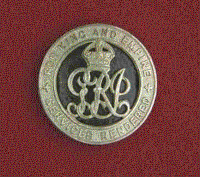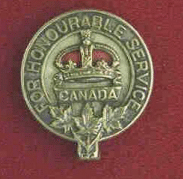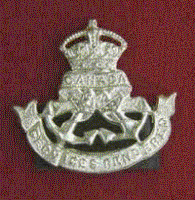Place of Birth: Port Hillford, Guys. Co., NS
Mother's Name: Anne Scott (McKeen) Mills
Father's Name: Robert Bruce Mills
Date of Enlistment: January 7, 1916
Regimental Number: 760760
Rank: Private
Force: Canadian Expeditionary Force
Name of Units: 121st Battalion ("Western Irish") & 29th Battalion ("Tobin's Tigers")
Location of service: England, France & Belgium
Occupation at Enlistment: Carpenter
Marital Status at Enlistment: Single
Next of Kin: Robert Mills, Glenelg, Guys. Co., NS
*****
For many of the young Guysborough County men who enlisted in the armed forces during the First World War, the passage across the Atlantic to Europe was their first - often only - journey to locations far from their native communities. This was not the case for Clayton Mills, who excursions to destinations far from home began several years before his military service.Clayton was the youngest of five children born to Robert Bruce and Anne Scott Mills. His father was a native of Indian Harbour, the son of Robert and Elizabeth (Suttis) Mills. His mother was born at "Cross Roads", the daughter of Alex and Sarah (MacMillan) McKeen of Aspen. The 1901 census lists his older siblings: sister Bessie (November 11, 1880), twins Sarah M. and Alexander (October 12, 1883) and brother Frank (June 23, 1886), the sibling closest to Clayton in age and a companion on some of his pre-war travels. Sometime before 1901, the family moved to Sherbrooke, where father Robert worked at the saw mill. By 1911, the family had relocated to the Forks (Glenelg), where Robert and Anne would spend the remainder of their days on the family farm.
This small Guysborough community, however, would not be "home" to Clayton. Like many of his generation, he was drawn to other parts of North America in search of work. In the pre-war years, able-bodied Maritimers boarded the "excursion train" in late summer and travelled to farms in western Canada, where they worked in the fields harvesting crops. Most returned to their Maritime homes before winter, heading west again the following year. Older brother Frank accompanied Clayton on several of these "excursions" - perhaps he was the first to venture west. Clayton decided to remain out west on at least one occasion prior the war. While the 1911 census lists Frank as residing in the family home in Glenelg, Clayton was living in a Calgary, Alta. boarding house.
 |
| "Harvest Train" Advertisement |
*****
Clayton spent the first months of military service at Vernon Camp, BC, honing the military skills required at the front. A medical examination conducted at the camp on July 4, 1916, confirms that he was still in Canada, but Clayton soon embarked on the long journey to the front lines. Sometime later that summer, the members of the 121st Battalion travelled by train across Canada. On August 14, 1916, they departed Halifax for England, docking in Liverpool ten days later. The men were then transported to the CEF military base at Bramshott, where they continued training. |
| 121st Battalion ("Western Irish") - Vernon Camp, BC, 1917 |
The 121st was one of two battalions that provided manpower for the 29th British Columbia infantry battalion. The latter was organized and commanded by Lt.-Col. Henry Seymour Tobin, a veteran of the RCMP and Boer War, and given the nickname "Tobin's Tigers". Upon arrival in Europe, the 29th was assigned to the 6th Infantry Brigade, 2nd Canadian Division and first saw action near Ypres, Belgium in October 1915. By the time Clayton reached France, the battalion had served one year on the front lines in Belgium and France and fought in the bloody Battle of the Somme (July 1916). No doubt, the newly arrived recruits benefitted immensely from their comrades' fighting experience.
 |
| 121st ("Western Irish") Battalion Badge |
 |
| The 29th Battalion advances at Vimy Ridge - April 9, 1917 |
After a break for training in September, Clayton returned to the front lines near Lens. On October 24, the battalion moved to Cassel, northwest of Lens, and then on to Belgium, arriving at Ypres on November 3. The following day, the men assumed positions along the front lines at Passchendaele. The fighting at this mud-strewn battlefield had commenced in July and was over by the time of the battalion's arrival. No doubt, Clayton and the men of the 29th were relieved to return to the more "hospitable" trenches of Lens on November 22.
 |
| Members of the 29th Battalion in France (date and location unknown) |
As there was little military activity at the front during the winter months, battle weary soldiers were often granted leave at this time. Clayton was amongst the fortunate soldiers chosen for such a break, departing for 14 days' leave - likely to England - on December 12 and returning to the battalion on December 29. His Christmas holiday was no doubt more comfortable than the one his comrades experienced in the front lines!
The battalion spent the first few months of 1918 in the trenches near Lens. The lull in fighting provided time for training when weather permitted. Clayton's dedication to his military duties is reflected in the "Good Conduct Badge" awarded to him on January 9, 1918. The remaining winter months passed quietly. The spring of 1918, however, would bring a return to battle as the German command put into action a bold plan it hoped would end the stalemate on the Western Front.
*****
In early 1918, the German command saw an opportunity to "knock the Allies out of the war before the United States' forces [recent entrants in the conflict] were fully committed to battle". (Cook 383) A December 1917 peace treaty with the new Communist government of Russia ended fighting on the Eastern Front, allowing Germany to move 33 divisions to the Western Front in support of a "spring offensive". German ranks along the front lines in Belgium and France swelled to 4 million men in almost 200 Divisions. |
| 29th Battalion Badge |
On March 21, the German offensive commenced with a massive artillery and machine gun barrage. German forces advanced 20 kilometres into Allied-held territory over a period of three days, capturing the strategically important city of Amiens. One reason for their success was the Allied decision to retreat in the interest of reducing the number of casualties, rather than "fight to the death" to hold ground. This strategy proved successful as the German infantry quickly advanced beyond the point where it could be supported by artillery. Overextended and vulnerable to counterattack, the offensive ground to a halt by late April, having failed to achieve a permanent breakthrough. Germany suffered 800 000 casualties in the fighting, many of whom were its best trained troops. As a result, its forces were much weaker by summer - a situation that eventually had severe consequences.
Clayton and his comrades spent March and April in the front lines southwest of Arras. The battalion was fortunate that this location was not a major target during the German offensive. Other than a severe gas and artillery attack on April 20, the 29th was relatively unscathed by the spring fighting and fortunate to be called into reserve on April 21. The months of May and June were spent in the Arras area, following a rotation of front line duty, rest and training in reserve.
On July 1 - Dominion Day - the battalion participated in the Canadian Corps Sports competition at Tinquex, winning the tug of war championship. The following day, the 6th Brigade was inspected by Lt. General Sir Arthur Currie and Prime Minister Borden at nearby Givenchy-Le Noble. The battalion spent the remainder of the month in training before returning to reserve positions behind the front lines near Amiens. For the men of the Canadian Corps - and for Clayton in particular - the war's events were about to take a significant turn.
 |
| The victorious 29th Battalion tug of war team at Tinquex, France - July 1, 1918 |
*****
The Canadian Corps was fortunate not to have borne the brunt of Germany's "Spring Offensive". While they endured heavy artillery bombardment, their lines were not the target of infantry assault. Their role, however, was critical in that they held down significant parts of the Allied lines not under direct attack. By mid-April, Canadian troops occupied one-fifth of the front trenches assigned to the British Expeditionary Force, allowing British units to concentrate on slowing and finally stopping the German offensive. Holding such an extensive stretch of the front line was no small feat for a fighting force of 100 000 men.The early summer months provided a much welcomed period of rest and training. The Canadian Corps, largely intact after the spring fighting, would form a key part of an Allied counter-offensive. Rebuilt to full strength with men drawn from reserve units in addition to the arrival of the first "conscripts", the Canadians were ready for battle by mid-summer. Their military skills would indeed be put to the test in the remaining months of the war.
By late summer, Allied commanders had completed plans for a counter-attack. German forces were physically exhausted, demoralized and weakened by the Spring Offensive's failure. A major assault might - indeed, did - bring the war to an end. The target chosen for its launch was the city of Amiens. This battle marked the beginning of "Canada's 100 Days" - the Canadian Corps' pivotal role in the campaign that brought the war to an end. It was also a battle that - fatally - involved Clayton and the men of the 29th Battalion.
Captured by the Germans during the Spring Offensive, Amiens was a critical railway junction between Paris and the port city of Boulogne, France. The Germans considered the area a "quiet sector" and therefore thinly spread their defensive forces along the front lines. The main part of the Canadian Corps, located in nearby trenches, formed for battle near Amiens in early August. The well rested Canadians joined American and Australian forces in what was intended to be a breakthrough assault on the city.
On the night of August 6-7, the 29th Battalion joined the rest of the Canadian Corps in positions at Tronville Wood in preparation for an attack on the village of Rosieres, adjacent to Amiens. An officer from the battalion's Company D described "the neighbouring woods [as] a seething mass of all branches of a present-day army: infantry, tanks, cavalry, and all the auxiliary services. In the daytime nothing could be seen… but at night all was bustle yet orderly,… just far enough behind the lines to be out of hearing of the enemy." No doubt, Clayton and the men of the 29th experienced a sense of nervous anticipation as the time for battle approached.
The Allied attack was launched at 4:30 am August 8. The 29th was not involved in the initial assault as Canada's 4th Brigade advanced an astonishing 13 kilometres into German territory - the greatest single day advance of the war. However, the question remained: Could this initial success be turned into a "knockout" blow on the following day? Several factors combined to make this unlikely. First of all, the Germans quickly moved much needed reinforcements into the Amiens area. The greater problem, however, proved to be a breakdown in co-ordination among Allied forces when the advance resumed on the morning of August 9.
 |
| Company B, 29th Battalion prepares for battle - Amiens, August 8, 1918 |
The 29th and 31 Battalions were ordered to advance through the village of Rosieres and capture section of light railroad just beyond its boundaries. To do so, Clayton and his comrades had to advance across more than1000 metres of open ground in broad daylight. To further complicate matters, artillery fire was weak and scattered, as the guns that had supported the previous day's successes had not yet been fully relocated. In fact, some of the shells fired in support of the August 9 attack fell behind the Allied front lines. To make matters even worse, a detachment of tanks scheduled to advance with the ground assault failed to reach the battlefield by the appointed time.
The battalion's other two companies also encountered stiff resistance as they moved across the open battlefield. An officer from Company C reported: "During the whole advance we were under heavy artillery and machine gun fire from the ridge north-east of the railroad…. We also encountered heavy machine gun fire from the town in front and from snipers in the trees." Company D's report states: "[Upon advancing] we were immediately met with heavy machine gun fire…. our left flank was held up by machine gun nests all along the railway." The men of the 29th pushed on nonetheless, one of its scouts observing that "our men were dropping in considerable numbers all down the line, though no hesitation was shown. On the left in particular heavy machine gun fire was thinning our ranks…."
 |
| Destroyed German transport on Amiens battlefield - August 8, 1918 |
 |
| Gravestone of Pte. Clayton R. Mills, Rosieres Communal Cemetery, France |
*****
Amiens indeed proved to be a turning point in the war. By the following day, battle lines once again solidified and the attack ground to a halt by August 13. However, Allied forces had advanced more than 24 kilometres and captured almost 30 000 German prisoners in the Amiens offensive, indicating that the German army was much weaker than its spring successes had suggested. While the Canadian Corps suffered significant casualties, its numbers were quickly replenished by 12 000 conscripts, returning wounded soldiers, and elements of the dispersed 5th Division. Over the next three months, the Corps spearheaded the Allied attack that resulted in the Armistice of November 11, 1918. All of this was made possible by the sacrifice made by the men who fought and died at Amiens. |
| Grave of Pte. Clayton R. Mills (marked with flower), Rosieres Communal Cemetery, France |
But the war was over for Clayton. The journeys that had taken him far from his birthplace did not bring him home. Rather, his final resting place is a small patch of foreign soil. In the days after the battle, Pte. Clayton R. Mills was buried at Rosieres Communal Cemetery Extension, Somme, France, alongside the comrades who lost their lives in the service of their country on that fateful August day.
Cook, Tim. Shock Troops: Canadians Fighting in the Great War 1917 - 1918. Toronto: Penguin Group, 2008.
McWilliams, James & Steel, R. James. Amiens: Dawn of Victory. Toronto: Dundurn Press, 2001.
Regimental Documents of Pte. Clayton R. Mills. Library & Archives Canada. RG 150, Accession 1992-93/166, Box 6211 - 57.
War Diaries of the 29th Battalion. Library and Archives Canada. Available online.
Background information and images of Pte. Mills' grave courtesy of his nephew John Selwyn Mills, Riverview, NB.
*****
Sources:
Cook, Tim. Shock Troops: Canadians Fighting in the Great War 1917 - 1918. Toronto: Penguin Group, 2008.
McWilliams, James & Steel, R. James. Amiens: Dawn of Victory. Toronto: Dundurn Press, 2001.
Regimental Documents of Pte. Clayton R. Mills. Library & Archives Canada. RG 150, Accession 1992-93/166, Box 6211 - 57.
War Diaries of the 29th Battalion. Library and Archives Canada. Available online.
Background information and images of Pte. Mills' grave courtesy of his nephew John Selwyn Mills, Riverview, NB.














